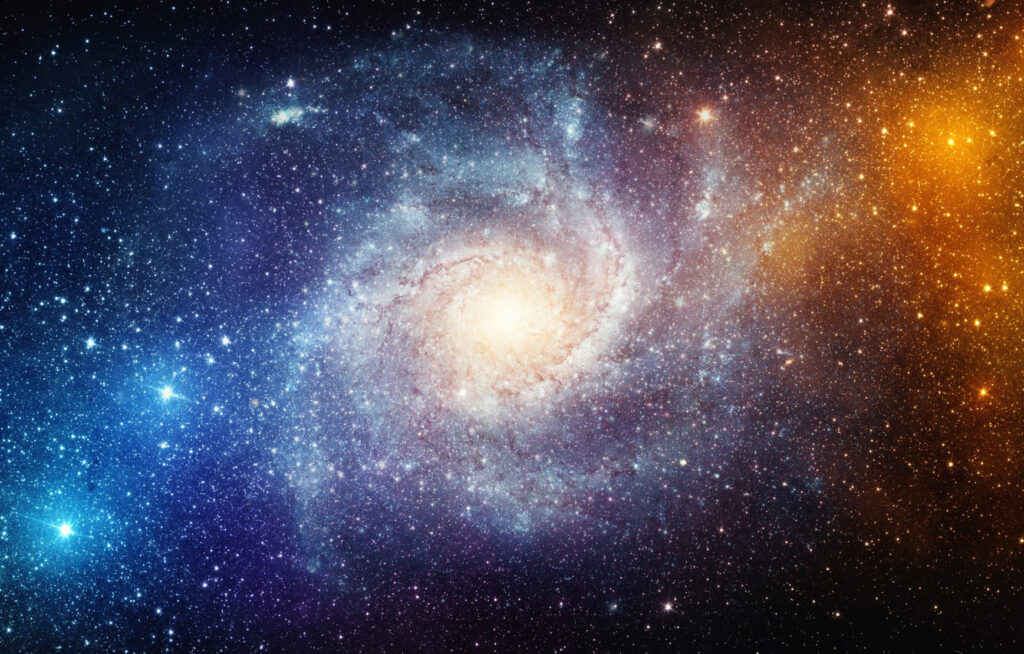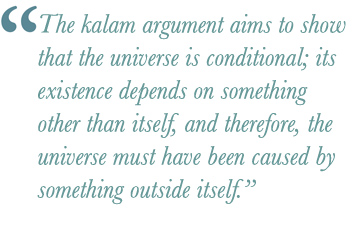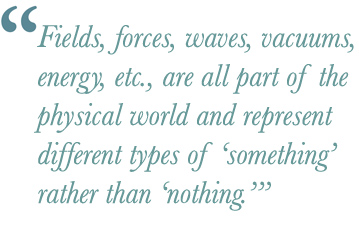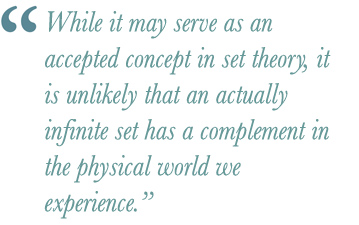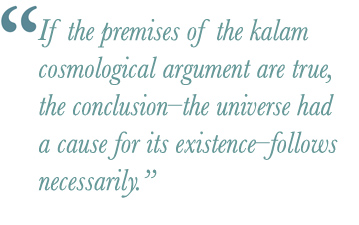Introduction
There are few, if any, subjects more contentious than the existence of God. Either God exists and created the universe, or he does not and may, therefore, be ignored. Committing one’s life to a God who is not there is, at best, a salve for one’s fear of the unknown and, at worst, a delusion of epic proportions.
Skeptics have mostly believed that either the universe has always existed or sprang up without cause from nothing[1] They often suggest that the notion that a supernatural entity caused the universe is questionable, thanks to the principle of sufficient reason. This principle affirms that everything that exists has a reason, cause, or ground.[2] If everything needs a reason, cause, or ground, the skeptic might ask, “What caused God?”
Thomas Aquinas (1225–1274 AD), perhaps the most influential theologian of the Middle Ages, argued that only finite, limited, contingent[3] things need a cause.[4] According to Aquinas, a regression of causes can legitimately stop at an uncaused Causer of all finite things: God. For Aquinas, God is a necessary being[5] that needs no cause.[6]
Many skeptics think they can simply circumvent this line of reasoning by assigning the title of necessary being to the material universe itself. Thus, one could say that, like God, the material universe is eternal, uncaused, and, therefore, serves as its own sufficient reason. Indeed, atheists often regard the universe as a necessary entity and thus claim that the universe needs no other cause. In other words, there is no need for God.
One way to address this counterclaim is to demonstrate that the universe likely had a cause for its existence. If one can show that the universe had a beginning, it would mean the universe itself is contingent and, thus, needs a cause. The rest of this essay argues that something outside the universe caused it to exist.
The Kalam Cosmological Argument
The kalam cosmological argument (KCA) does not attempt to prove the existence of a supernatural being, let alone the existence of the Christian God. Instead, it endeavors to demonstrate the likelihood that something brought the universe into existence a finite time ago.[7] In other words, the argument aims to show that the universe is conditional; its existence depends on something other than itself. Therefore, the universe is contingent and must have been caused by, or arisen from, something other.
The KCA represents a crucial first step in understanding the rational implications of the claim that the universe has always existed. If one can show that the universe had a beginning, the discussion can move on to “who” or “what” was responsible for its coming into being.
The KCA is nothing if not simple. It can be stated like this:[8]
- Whatever begins to exist has a cause for its existence.
- The universe began to exist.
- Therefore, the universe had a cause for its existence.
Defense of the First Premise
Does everything that comes into existence require a cause? Causality appears to be a universal part of human experience, a rational norm that is self-evident or reducible to the self-evident. While some may question that causality is a necessary feature of the world, for science this is not an option. The scientific method assumes causality and attempts to find causes for all effects of interest.
Premise 1 of the KCA tells us that everything that comes into existence has a cause. But what could have caused the universe? Could it have simply sprung into existence from nothing whatsoever? No! And it is crucial to understand why the universe cannot arise from nothing. Though nothingness may be an idea that we can think about and perhaps even formulate a concept of in our minds, “nothing” has no existential reality, no properties that would mark it as something in the real world. Indeed, the principle of negative causality tells us:
Nothing cannot cause something. Only being can cause being. ‘Nothing’ does not exist, and only what exists can cause existence since the very concept of “cause” implies an existing thing that has the power to affect another. From absolutely nothing comes absolutely nothing.[9]
Scientists who claim to have generated something from nothing in a lab are mistaken. The “nothing” in these experimental settings is always “something” in disguise. Fields, forces, waves, vacuums, energy, etc., are all part of the physical world and represent different types of “something” rather than “nothing.”
Some will tell us that quantum indeterminacy suggests that subatomic particles pop into existence from nothing. However, indeterminacy does not necessarily mean that the particles are uncaused. Since the process appears to be guided by the laws of quantum mechanics, it seems plausible to suggest a causal principle at work.
David Hume had doubts about causality. He thought that since one can imagine circumstances where something can come into existence without a cause, then it must be possible in reality. Hume stated that if one can think of a circumstance where, for example, a brick comes into existence without a cause, then “one might conclude that it is possible that a brick pops into existence uncaused.”[10] However, the defender of causality can question whether mere imagination can be responsible for actual existence. After all, one can imagine a unicorn, but that doesn’t mean one exists.[11]
As Alexander Pruss points out, there is a difference between imagining something without its cause and imagining something along with its cause.[12] When we imagine an empty room, we conceptualize it in a way that approximates how it would generally appear in our world. So, we might imagine a room with four walls, a ceiling, a floor, and without furniture. But it is unlikely that we would imagine an empty room without air or as a quantum vacuum state. As Pruss suggests, there is no reason to think we can imagine a perfect vacuum.[13] Even if one imagines a series of possible mental images, this says “little or nothing about the ontological possibility of things materializing out of nothing.”[14]
Ultimately, even Hume had to acknowledge that his academic denial of causality couldn’t remove his belief that it was true. Said Hume: “But allow me to tell you that I never asserted so absurd a Proposition as that anything might arise without a cause: I only maintain’d, that our Certainty of Falshood of that Proposition proceeded neither from Intuition nor Demonstration; but from another Source.”[15]
The notion that something can be caused by nothing contradicts human experience and intuition and is also contrary to science, which seeks causal explanations for all types of events. For every effect, there must have been some action (cause) that moved or changed an existing thing from an initial state toward some other state. Therefore, the idea that something (i.e., that which exists) is caused by nothing (i.e., that which does not exist) is fanciful. Anyone who claims that something can come from nothing must shoulder the burden of proof of how such a thing might occur. Moreover, if something can come into being without a cause, why don’t we observe this happening all the time?
Defense of the Second Premise
Did the universe have a beginning? Many believe that our universe is infinite (i.e., has always existed) and, therefore, needs no cause. In support of premise 2, the KCA presents two independent philosophical arguments and two scientific confirmations.
Actual versus Potential Infinite
To fully appreciate the kalam argument’s second premise, one must understand the concepts of potential and actual infinity. Identifying and describing these two concepts will help us understand whether an infinite or eternal universe is possible.
A potential infinite is a series of things (e.g., numbers, days, etc.) that continue incrementally toward infinity but never arrive. A potential infinite represents a counting process that is finite at any point but never reaches a final (or initial) cause. So, if you count the days into an infinite past, you will never finish counting back to the first day because a potential infinite never becomes an actual infinite. Of course, this simply won’t do as an explanation for an infinitely existing universe because it leads to an infinite regress of causes, which is something that does not concur with the findings of current science or rational thought (as explained below).
On the other hand, an actual infinite is a (hypothetically) complete group of things with infinite members. In other words, the set always consists of an infinite number of things. While this concept appears in certain types of mathematics (e.g., set theory), an actual infinite most likely cannot exist in the real world because this outcome would reduce to an absurdity.
The First Supporting Argument
The first supporting argument is this: An actual infinite set of things cannot exist in the real world and, therefore, the universe cannot extend infinitely into the past. To explain why this is true, it helps to assume—for the sake of argument—that an actual infinite does exist and then show how this results in absurd consequences.
Consider a hypothetical library with an assumed infinite number of red and black books.[16] The number of members can never change in an actually infinite set because it must always be infinite. Therefore, no matter what happens, the library will always have a completed infinite set of books. While it may seem contradictory to say that there are as many red books as red and black books combined, this is the implication of an actually infinite set. Moreover, suppose one removes all the black books from the library. In that case, there will still be an infinite number of books in the collection because an actually infinite set is always infinite in number.
Let us now suppose that each book in the library has infinite pages. In an actually infinite library, there would be just as many pages in the first book as in the entire collection. But how can that be? One can readily see that if there are the same number of pages in one book as in all the others combined, this would lead to a nonsensical situation in the real world. And yet, such an outcome is guaranteed by an actually infinite set.
The above examples demonstrate the futility of appealing to the concept of actual infinity for describing things in the real world, especially when proposed as an explanation of an infinite universe. In mathematical set theory, it is possible to have infinite sets that are larger or smaller than other infinite sets. While it may serve as an accepted concept in set theory, it is unlikely that an actual infinite has a complement in the physical world we experience. In other words, it is most likely impossible for an actual infinite to be instantiated (i.e., represented by an actual instance) in the real world.
The Second Supporting Argument
The second supporting argument is this: Forming an actual infinite by successive addition is impossible. If one starts by adding one number at a time or working backward one day, month, or year at a time, one could never reach an actual infinite through successive addition because one could always add or subtract another number (i.e., day, month, year). As stated above, this would lead to an infinite regress or a never-ending series of causes (i.e., a potential infinite).
So, what is the practical problem of never arriving at an actual infinite through successive addition? Suppose that for an event occurring at the present moment, there was a cause, and for that event, there was another cause, which resulted from another cause, which was caused by something else, and so on into the never-ending stream of past events. In an infinite set of events, the chain of antecedent causes can be traced backward but never reaches the first cause because there will always be one more cause to add. But the problem is this: If just one of these past events has not already happened (i.e., been caused or actualized), then the present moment could have never arrived. Any chain of events must have a first member because, without a first cause, there could be no second, third, or nth cause. Each past event must have already happened for a present event to occur. But this is impossible because an actually infinite regression of causes can have no first cause. Therefore, the universe cannot be actually infinite in the past.
Based on the two philosophical arguments above, the universe could not be actually infinite in the past (or future, for that matter); it must have had a beginning. But the KCA does not end there. Two scientific confirmations add explanatory scope and power to the two philosophical arguments.
The First Scientific Confirmation
The first scientific confirmation that the universe began to exist comes from Expansion Theory. This theory has its roots in the works of Alexander Friedmann and Georges Lemaître, who, applying the general theory of relativity, predicted that space, as it continues to expand, will become less and less dense. For our purposes, this finding implies that if you reverse the expansion process, you will eventually arrive at a fully contracted universe compressed into the highest possible density in the smallest possible space. This condensed state of matter, the initial singularity, constituted the universe’s beginning.[17]
In 1929, Edwin Hubble—an American astronomer—added experimental support to expansion theory by demonstrating that the light at the far end of galaxies is shifting toward the red end of the spectrum, which indicates that the light sources are receding from view. No matter which direction one looks, distant galaxies are racing apart. And, if the universe is expanding, it must have once existed in a contracted state. Hubble’s observations pointed to a time in the distant past when the universe was incredibly small and dense. The subsequent eruption is called the Big Bang.[18] Thus, expansion theory provides evidence that the universe had a beginning, which supports premise 1: everything that begins to exist has a cause.
One possible conception of expansion theory is a contracting universe that starts with a big bang and ends with a “big crunch.” In this scenario, the universe would stop expanding and eventually collapse. If this were the case, the universe would suffer death by sudden obliteration, or as Davies puts it: “The big crunch is like the big bang in reverse.”[19] While we may find out in the future that such a theory is true, this would not change the likelihood that our universe had a beginning, and if and when it crunches, this will represent the end of space, time, and matter.
A more recent update to expansion theory—the theory of dark energy—asserts that the expansion rate is now speeding up. Dark energy, which is thought to comprise approximately 70 percent of the universe’s total energy, acts like antigravity, allowing space to expand more and more rapidly. If true, this would mean that the universe will likely expand forever and with increasing speed.[20] And yet, this theory, too, points to a universe that had a beginning.
Finally, the Borde-Guth-Vilenkin theorem proves that classical space-time, under a single, very general condition, cannot be extended to past infinity but must reach a boundary at some point in the finite past. In an article titled “The Beginning of the Universe,” physicist Alexander Vilenkin states, “If the universe is, on average, expanding, then its history cannot be indefinitely continued into the past.”[21] In answering the question, “Did the universe have a beginning?” Vilenkin says, “It probably did.” At least, he concludes, “We have no viable models for an eternal universe.”[22]
The Second Scientific Confirmation
The second scientific confirmation that the universe began to exist comes from the second law of thermodynamics. In a closed system, all substances will eventually reach a state of maximum disorder (i.e., entropy) and thermodynamic equilibrium.[23] One of the implications of this theory is that the universe will eventually run out of thermodynamic free energy, and, in that case, the universe will end in heat death.[24] In other words, our universe not only had a beginning at a finite point in the past but will eventually become inert in the future. In this scenario, if the universe extended infinitely into the past, it would have long since reached heat death, and we would not be around to contemplate it. The fact that it hasn’t yet reached heat death means that the universe must have had a beginning.
Many physicists have pointed out the accumulating evidence supporting multiple parallel universes (“many-worlds” or “multiverse”).[25] Multiverse theories have one glaring feature in common: They take us far afield from the historical foundations of science. According to theoretical physicist Sabine Hossenfelder,[26] the absence of observation and testing is the central problem. Says Hossenfelder, these universes are “causally disconnected from us.”[27] There is simply no way to observe other universes besides our own and, therefore, no way of testing the validity of the multiverse theory. After all, how would one test a hypothesis when no data is forthcoming? Hossenfelder concludes: “The vast majority of multiverse ideas are presently untestable, and will remain so eternally.”[28] Thus, purely theoretical constructs, like the multiverse, can never be explained scientifically. Instead, they must be based on numerous experimentally unsupported assumptions and, ultimately, accepted solely by trusting the predictive power of the theory in question.
Nevertheless, even if some theory of a multiverse turns out to be proven true, it would not only be compatible with theism, but theism may provide the best explanation for the multiverse. The multiverse may be more compatible with theism than naturalism because an unbounded cause better explains an infinite set of universes than a random cause. If a multiverse exists, there is no need to postulate speculative theories (e.g., string theory, inflationary theory, etc.) when a simpler, more coherent explanation is that transcendent intelligence designed the universe to support life.
Conclusion
If the premises of the Kalam Cosmological Argument are true, the conclusion—the universe had a cause for its existence—follows necessarily. While the limited scope of the present essay will not allow the author to make further inferences, the reader should nevertheless reflect on the magnitude of the conclusion: the universe was caused to exist. That something caused the vastness of the “universe” should reveal something important about the nature of that cause. The universe could not have caused itself, nor could it have always existed, nor did it suddenly materialize out of nothing; it must have been caused by something transcendent to the universe.
The KCA proper doesn’t address the question of who or what caused the universe. Nevertheless, its conclusion is consistent with the claim that a divine being or enormously powerful creative Mind designed and brought about the universe. In other words, there is nothing in the philosophical or scientific evidence that precludes the existence of God, and there is good reason to believe that something outside the universe caused the universe.
About the Author
David P. Diaz, Ed.D. is an author and retired college professor. His writings have spanned the gamut from peer-reviewed technical articles to his memoir, which won the 2006 American Book Award. Dr. Diaz holds a Bachelor’s and Master of Science degrees from California Polytechnic State University, a Master of Arts in Philosophical Apologetics from Houston Christian University, and a Doctor of Education specializing in Computing and Information Technology from Nova Southeastern University. [back to top]
Footnotes
[1] For this paper, I am defining “nothing” as precisely that—NO THING. It is the complete opposite of something (substance); it has no essence, form, or properties and, therefore, no existence.
[2] Yitzhak Y. Melamed and Martin Lin, “Principle of Sufficient Reason,” The Stanford Encyclopedia of Philosophy (Summer 2021 Edition), Edward N. Zalta (ed.), https://plato.stanford.edu/archives/sum2021/entries/sufficient-reason/.
[3] Contingent or finite things are those that could not have existed on their own (i.e., had the potential to not exist) and are, therefore, dependent on something else for their existence.
[4] Thomas Aquinas, Summa Theologica. Vol. 1. Translated by Fathers of the English Dominican Province (Westminster, MD: Christian Classics, 1981), Pt. 1 Q2 Art. 3 (third way).
[5] A necessary being is one that could not have failed to exist. In other words, a necessary being cannot not exist and, therefore, serves as the cause of all things that exist.
[6] Aquinas, Summa Theologica, Pt. 1 Q2 Art.3.
[7] The kalam cosmological argument had its foundations in the work of Christian philosopher John Philoponus (AD 490–570) and became popular among Arabic philosophers in the late Middle Ages. More recently, it has been further developed by William Lane Craig, The Kalam Cosmological Argument (Eugene, OR: Wipf and Stock Publishers, 2000).
[8] The kalam argument has different statements; the one put forward here is, I think, its simplest form. This formulation of the argument comes from Craig, The Kalam Cosmological Argument, 63.
[9] Norman L Geisler, The Big Book of Christian Apologetics: an A to Z Guide (Grand Rapids, MI: Baker Books, 2012), 171.
[10] As cited in Alexander R. Pruss, “The Leibnizian Cosmological Argument,” in The Blackwell Companion to Natural Theology, ed. William Lane Craig, and James Porter Moreland (Malden, MA: Wiley-Blackwell a John Wiley & Sons, Ltd., Publication, 2012), 47.
[11] One might ask, “What would be the difference between one who says that God exists and one who suggests that unicorns (or Santa Claus or fairies) are responsible for all of the unexplained phenomena in the world?” The biggest difference is that over 80% of the human population believes in a “God” or “gods,” and nearly 60% believe in a monotheistic God. On the other hand, nobody that I am aware of believes that unicorns are responsible for unexplained phenomena. Beyond that, there is abundant evidence for the existence of God. Indeed, as philosopher William Lane Craig has pointed out: “Christian philosophy is experiencing a veritable renaissance, reinvigorating natural theology, at a time when science is more open to the existence of a transcendent Creator and Designer of the cosmos.” William Lane Craig, Reasonable Faith, 3rd edition (Wheaton, IL: Crossway, 2008), 18.
[12] As cited in Pruss, “The Leibnizian Cosmological Argument,” 47.
[13] Ibid.
[14] Douglas Groothuis, Christian Apologetics: A Comprehensive Case for Biblical Faith (Downers Grove, IL: Intervarsity Press, 2022), 208.
[15] As cited in Craig, The Kalam Cosmological Argument, 168.
[16] From J. P. Moreland, Scaling the Secular City: A Defense of Christianity (Grand Rapids, MI: Baker Book House, 1987), 23.
[17] A singularity is “a point at which a function takes an infinite value, especially in space-time when matter is infinitely dense, as at the centre of a black hole” (Oxford Living Dictionaries, s.v. “singularity”). Infinite, in this sense, refers to the point where the laws of physics break down. Such a point represents the boundary of time in which space and time no longer exist. Some quantum cosmology models introduce “imaginary numbers” for the time variable in the Standard gravitational equations. This effectively eliminates a singularity in the model. However, it does not contradict the assertion that the universe had a beginning. There would still be a beginning, albeit without a singularity. For further discussion of a singularity, see William Lane Craig and James D. Sinclair, “The Kalam Cosmological Argument,” in The Blackwell Companion to Natural Theology, ed. William Lane Craig, and James Porter Moreland (Malden, MA: Wiley-Blackwell a John Wiley & Sons, Ltd., Publication, 2012), 129–30.
[18] Although English astrophysicist Sir Fred Hoyle (1915–2001) coined the term “Big Bang” on a BBC radio program, he rejected the theory as an unlikely explanation of the beginning of the universe.
[19] Paul Davies, God and the New Physics (New York, NY: Simon & Schuster, 1984), 205.
[20] K. R. Dienes, “Rethinking the Rules of Reality,” presented at University of Arizona lecture series 2017 Rethinking Reality, June 12, 2017.
[21] Alexander Vilenkin, “The Beginning of the Universe,” Inference: International Review of Science 1, no. 4 (2015), https://doi.org/10.37282/991819.15.18.
[22] Ibid.
[23] A closed system refers to a universe with no mass being fed into or out of it. The universe has finite mass and contains sufficient density/gravitational force to stop (or perhaps reverse) the expansion that commenced at the Big Bang.
[24] For more on the heat death of the universe, see “Heat Death of the Universe,” Wikipedia, https://en.m.wikipedia.org/wiki/Heat_death_of_the_universe.
[25] Four levels of the multiverse have been distinguished: (1) Space beyond the observable universe; (2) “Bubble” universes spawned in inflationary cosmology; (3) Parallel “many-worlds;” (4) An all-encompassing version where mathematically possible existence is equivalent to actual physical existence. See W. David Beck and Max Andrews, “God and the Multiverse,” Philosophia Christi 16, no. 1 (2014): pp. 101-115, https://doi.org/10.5840/pc20141616, 104–06.
[26] See Sabine Hossenfelder, Lost in Math: How Beauty Leads Physics Astray (New York, NY: Basic Books, 2018).
[27] Ibid., 101.
[28] Hossenfelder appropriately qualifies her statement: “The existing predictions demonstrate that the multiverse is in principle amenable to experimental test, but these tests are useful only for very specific scenarios” (p. 107).
